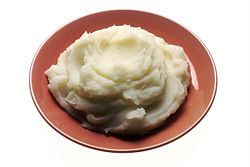Mashed potato: Difference between revisions
No edit summary |
Prestonlewis (talk | contribs) m Undid revision 333175444 by 132.3.9.68 (talk) Undo edit which declares "smashed potatoes" to not exist. |
||
| Line 2: | Line 2: | ||
[[Image:MashedPotatoes.jpg|thumb|250px|right|Mashed potatoes.]] |
[[Image:MashedPotatoes.jpg|thumb|250px|right|Mashed potatoes.]] |
||
[[Image:MashShy.jpg|thumb|250px|Decorated mashed potatoes, ''Schynige Platte''.]] |
[[Image:MashShy.jpg|thumb|250px|Decorated mashed potatoes, ''Schynige Platte''.]] |
||
'''Mashed potatoes''' or '''Smashed potatoes |
'''Mashed potatoes''' or '''Smashed potatoes''' is one way of serving [[potatoes]]. It is made by mashing freshly boiled (peeled or unpeeled), or sometimes baked, potatoes with a [[Potato ricer|ricer]], fork or [[potato masher]]. Dehydrated and frozen mashed potatoes are also available in many American or European countries. |
||
==Ingredients== |
==Ingredients== |
||
Revision as of 13:14, 25 December 2009


Mashed potatoes or Smashed potatoes is one way of serving potatoes. It is made by mashing freshly boiled (peeled or unpeeled), or sometimes baked, potatoes with a ricer, fork or potato masher. Dehydrated and frozen mashed potatoes are also available in many American or European countries.
Ingredients
The use of “floury” types of potato is usually recommended, although “waxy” potatoes are sometimes used for a different texture. Butter (or vegetable oil) and milk or cream is usually added to make smooth, well-flavoured mashed potato. Basic seasonings include salt, pepper, and rosemary[1]. Other popular ingredients and seasonings include: garlic, cheese, bacon bits, sour cream, crisp onion or spring onion, mustard, spices, chopped herbs such as parsley, white turnip, and wasabi. A French variation adds egg yolk for Pommes duchesse, piped through a pastry tube into wavy ribbons and rosettes, brushed with butter and lightly browned. In low-calorie recipes, milk, cream, and butter are often replaced with soup stock or broth.
Preparation
Cooking
Mashed potato can take on a glue-like consistency when the starch grains in the potato burst. To avoid this, potatoes should not be overcooked. Thinly slicing the potatoes allows them to cook evenly where larger pieces would be either overcooked on the outside by the time heat had penetrated to cook the center, or raw inside. Heston Blumenthal recommends cooking the sliced potatoes for 40 minutes at a controlled temperature of 70°C. [2] To avoid the need for temperature control, the potatoes can be boiled until just cooked (10 to 12 minutes).
Mashing
Potatoes are best mashed before adding butter, etc.; the butter or liquid lubricates the lumps of potato, making them easier to break up. If a food processor or similar is used for mashing, it will mechanically break the starch grains and produce an undesirable “gluey” result.
Uses
Mashed potato can be served together with other dishes, or can be an ingredient of various other dishes, including shepherd’s and cottage pie, pierogies, colcannon, dumplings, Cornish pasties, potato croquettes, gnocchi, etc.
Gravy can be poured onto mashed potato, sometimes spooned into a hollow, called a “tater crater.” (Potatoes formed into a "tater crater" are often called "volcanoes", usually by children, as the potatoes resemble a mountain with gravy/lava pouring out.) Many countries have English-style shops that sell pie and mash and bangers and mash.
See also
References
- ^ Recipe for mashed potato [1]
- ^ "a brilliant technique that produces restaurant-quality mashed potato"
